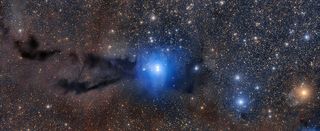Young Stars Shine in Nearby Stellar Nursery Lupus 3
A new space picture shows brilliant blue stars shining from the gloom of a cosmic dust cloud called Lupus 3. The cosmic light show is taking place about 600 light-years from Earth, and shows how young stars are born from clumps of gas and dust.
The image is based on data from two European Southern Observatory (ESO) telescopes in Chile: the VLT Survey Telescope at Paranal Observatory, and the MPG/ESO 2.2-meter telescope at La Silla. In a statement, ESO said the new image is "the most detailed image taken so far of this region." [The Fabulous Lives of Nebulas]
Lupus 3 is an example of a nebula, a huge region of dust and gas that can sometimes be hundreds of light-years long. While some nebulas are very bright, Lupus 3 is an example of a "dark" nebula — a situation in which dust blocks the light of the objects within it.

"They [dark nebulas] are also known as absorption nebulae, because they are made up of cold, dense particles of dust that absorb and scatter light as it passes through the cloud," ESO representatives said in the statement.
Lupus 3, which looks a bit like a snake, is a powerhouse for star formation, just like many nebulas. Within the nebula are young stars and protostars — gas in the process of collapsing to form a star's core.
Stars often form when a gravitational influence (such as a passing star) creates a disturbance in the nebula. Denser parts of the nebula condense and contract due to gravity, warming up and increasing the pressure inside the dust and gas. In the densest parts of the nebula, gravity can be strong enough to form protostars.
"The two brilliant stars in the center of this image underwent this very process," ESO stated.
Get the Space.com Newsletter
Breaking space news, the latest updates on rocket launches, skywatching events and more!
"Early in their lives, the radiation they emitted was largely blocked by the thick veil of their host nebula, visible only to telescopes at infrared and radio wavelengths," ESO representatives said. "But as they grew hotter and brighter, their intense radiation and strong stellar winds swept the surrounding areas clear of gas and dust, allowing them to emerge gloriously from their gloomy nursery to shine brightly."
The stars in the image, ESO noted, are too young to shine from nuclear fusion, the process that powers stars like our sun. The bright light instead comes from the cores of the young stars contracting as gravitational energy converts into heat.
Famous examples of dark nebulas include the Coalsack Nebula (in the constellation Crux, visible from the Southern Hemisphere) and the Great Rift (between the constellations Cygnus and Aquila in northern skies). Both of these dark nebulas are visible with the naked eye, ESO noted. Lupus 3, however, is one of the closest dark nebulas to Earth, and for this reason, astronomers often study it to better understand how star formation works.
Follow us @Spacedotcom, Facebook and Google+. Original article on Space.com.
Join our Space Forums to keep talking space on the latest missions, night sky and more! And if you have a news tip, correction or comment, let us know at: community@space.com.

Elizabeth Howell (she/her), Ph.D., is a staff writer in the spaceflight channel since 2022 covering diversity, education and gaming as well. She was contributing writer for Space.com for 10 years before joining full-time. Elizabeth's reporting includes multiple exclusives with the White House and Office of the Vice-President of the United States, an exclusive conversation with aspiring space tourist (and NSYNC bassist) Lance Bass, speaking several times with the International Space Station, witnessing five human spaceflight launches on two continents, flying parabolic, working inside a spacesuit, and participating in a simulated Mars mission. Her latest book, "Why Am I Taller?", is co-written with astronaut Dave Williams. Elizabeth holds a Ph.D. and M.Sc. in Space Studies from the University of North Dakota, a Bachelor of Journalism from Canada's Carleton University and a Bachelor of History from Canada's Athabasca University. Elizabeth is also a post-secondary instructor in communications and science at several institutions since 2015; her experience includes developing and teaching an astronomy course at Canada's Algonquin College (with Indigenous content as well) to more than 1,000 students since 2020. Elizabeth first got interested in space after watching the movie Apollo 13 in 1996, and still wants to be an astronaut someday. Mastodon: https://qoto.org/@howellspace
Most Popular

